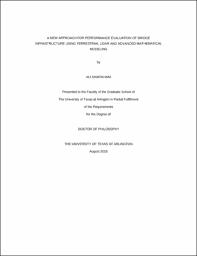
ATTENTION: The works hosted here are being migrated to a new repository that will consolidate resources, improve discoverability, and better show UTA's research impact on the global community. We will update authors as the migration progresses. Please see MavMatrix for more information.
Show simple item record
| dc.contributor.advisor | Puppala, Anand | |
| dc.creator | Shafikhani, Ali | |
| dc.date.accessioned | 2020-08-04T18:26:33Z | |
| dc.date.available | 2020-08-04T18:26:33Z | |
| dc.date.created | 2018-08 | |
| dc.date.issued | 2018-08-20 | |
| dc.date.submitted | August 2018 | |
| dc.identifier.uri | http://hdl.handle.net/10106/29331 | |
| dc.description.abstract | High plastic expansive clays when subjected to different climatic conditions undergo large ground movements causing distress to infrastructures including bridges, pavements, buildings, retaining structures, and others. Performance assessment of these structures built on problematic soils such as expansive clays is important to reduce maintenance and extending the design life of infrastructure. Rapid developments in remote sensing technologies with precise evaluation have influenced the monitoring techniques for assessing the health condition of civil infrastructure projects. While these technologies have considerably aided in performance evaluation, cogent procedures for evaluating the ground movements are still required that integrates technologies, climatic factors, soil behavior models. This research study presents an integrated approach using the Three-Dimensional Terrestrial Laser Scanning (3D-TLS) technique and advanced mathematical modeling (system identification approach) for assessing the performance of the bridge infrastructure including highway embankment, bridge deck, bridge approach slab, bridge abutments, and columns. First, an optimized framework is developed to evaluate ground movements using 3D-TLS technique, which is an active-remote sensing Light Detection and Ranging (LiDAR) remote sensing technology that uses near-infrared light to monitor physical characteristics of earth’s surface. The ground movements from the processed scans, and climatic factor parameters including temperature and precipitation variations were used to develop advanced mathematical models of dynamic systems using collected time-series data. The validation of the developed integrated framework is illustrated on a test site built on high plastic expansive clay soils located in North Texas. Cost-Benefit Analysis (COA) is performed to compare 3D-TLS remote sensing and prevalent monitoring approaches. This research highlights the integration of latest technological developments with advanced mathematical models to predict the condition of a bridge infrastructure. | |
| dc.format.mimetype | application/pdf | |
| dc.language.iso | en_US | |
| dc.subject | Performance Evaluation | |
| dc.subject | Bridge Infrastructure | |
| dc.subject | Remote Sensing | |
| dc.subject | LiDAR | |
| dc.subject | System Identification | |
| dc.subject | Ground Movement Prediction Model: Pavement | |
| dc.title | A NEW APPROACH FOR PERFORMANCE EVALUATION OF BRIDGE INFRASTRUCTURE USING TERRESTRIAL LIDAR AND ADVANCED MATHEMATICAL MODELING | |
| dc.type | Thesis | |
| dc.degree.department | Civil Engineering | |
| dc.degree.name | Doctor of Philosophy in Civil Engineering | |
| dc.date.updated | 2020-08-04T18:26:33Z | |
| thesis.degree.department | Civil Engineering | |
| thesis.degree.grantor | The University of Texas at Arlington | |
| thesis.degree.level | Doctoral | |
| thesis.degree.name | Doctor of Philosophy in Civil Engineering | |
| dc.type.material | text | |
| dc.creator.orcid | 0000-0003-3959-4144 | |
Files in this item
- Name:
- SHAFIKHANI-DISSERTATION-2018.pdf
- Size:
- 7.199Mb
- Format:
- PDF
This item appears in the following Collection(s)
Show simple item record


